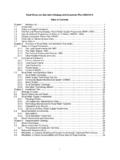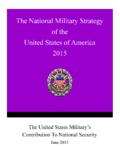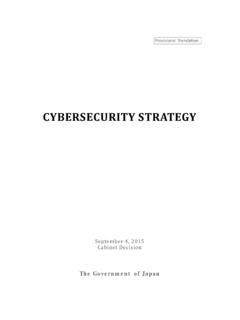Transcription of Diving Sector Strategy 2015 - 2018
1 Diving INDUSTRY Strategy 2015 TO 2018 STRATEGIC CONTEXT 1 This Strategy sets out how HSE s Energy Division will regulate the health and safety of all Diving at work activities. It covers what HSE will do to regulate the Diving industry and also what Diving contractors, their clients and other industry stakeholders should do to improve the health and safety performance of the industry. 2 HSE s Diving Group has responsibility for enforcing the Diving at Work Regulations 1997 (DWR97) which apply to all Diving carried out in Great Britain where at least one person who is taking part is at work. Diving at work covers a wide range of activities from deep saturation Diving in support of the offshore oil and gas industry to recreational instruction by an individual professional instructor. DESCRIPTION OF THE INDUSTRY 3 This is a geographically and technically diverse industry which operates across the whole of the UK - from the most inaccessible inland locations to the furthest offshore installation.
2 The industry has in excess of 50,000 people "at risk" (including members of the public undergoing paid instruction). The Strategy aims to secure the safety of those working or affected by the different sectors of the Diving industry. The industry includes the following sectors: Offshore 4. This Sector includes all Diving operations in connection with offshore installations, wells and pipeline works, any Diving using closed bell or saturation Diving techniques and where Diving takes place from vessels maintaining station by the use of dynamic positioning. It also includes Diving operations in UK designated areas of the continental shelf undertaken in connection with offshore installations, energy structures wind farms, emerging energy technologies (EETs), wells and pipeline works, and with those parts of mines which extend outside the 12-mile limit.
3 5 Worldwide, there continues to be a high level of demand for experienced divers, supervisors and support staff. The age profile of this internationally mobile workforce means that there are likely to be shortages of key personnel for some time. The commercial Diving schools are training new divers at an unprecedented rate, but it will take time to close the gap in experience. Ensuring that all Diving team members (including support staff) are suitably qualified and competent is an ongoing challenge for all offshore Diving contractors. 6. Saturation Diving takes place from complex and expensive Diving Support Vessels (DSVs) which work around the world and vary greatly in size, capability and age. Some of the older vessels present significant challenges in terms of reliability and safety and many are no longer considered suitable for the North Sea.
4 The latest generation of larger DSVs with complex computer controlled systems have proved to be very capable, but have also brought some new challenges for their operators, the classification societies and for the regulators. Adapting existing guidance and procedures to these Programmable Logic Controller (PLC) systems is an ongoing process and recent incidents have highlighted the need for further work in this area. Proactive inspection of these vessels and older assets within the offshore Diving industry remains one of the highest priorities for HSE s Diving inspection teams. Other Diving techniques include installation based Diving (IBD) where equipment and Diving teams embark on an installation for a fixed duration. Some air range Diving work is also carried out using small daughter craft operating from a mother vessel immediately adjacent to an installation or FPSO.
5 Inland/Inshore 7 This Sector is perhaps the most diverse. It includes all Diving projects conducted in support of civil engineering or marine-related projects and fish farming inshore (within territorial waters adjacent to Great Britain) and inland (docks, harbours, rivers, culverts, canals, lakes, ponds and reservoirs) and in tanks and swimming pools. The work involves a wide range of activities, ranging from complex marine construction and engineering tasks, salvage and ship repair through to simple underwater inspection. 8 This Sector has experienced a marked increase in activity in some areas such as Diving in support of offshore renewable energy projects, but other areas have suffered from the recent economic downturn. Much of the work is carried out in a highly competitive market with relatively low profit margins.
6 This often results in pressure to reduce costs by using the absolute minimum resource in terms of team size and equipment. Scientists and Archaeologists 9 This Sector includes scientific research or scientific educational instruction and underwater archaeology - including investigation of sites of historic interest and the recovery from such sites of articles for preservation and further analysis. 10 This small and specialised industry Sector has experienced relatively few problems in recent years and demonstrates a significant degree of self regulation. However, recent changes in environmental legislation are likely to lead to an increase in both scientific and archaeological survey work prior to any marine construction, extraction or development projects. Media 11 This relatively small Sector covers activities such as film and television programme making.
7 Media divers include stunt people, journalists, presenters, photographers, camera operators, sound and lighting technicians, and the unit crew required to dive in support of underwater media work. Media projects are often small scale and of short duration and therefore difficult to inspect at short notice. In the past, HSE has concentrated on the relatively small number of client companies involved in this Sector and this is likely to continue. Recreational 12 This is numerically the largest Sector of the Diving industry, with the majority of those at risk being members of the public paying for professional instruction. Recreational Diving training is carried out in the UK by a number of national and international training organisations. The majority of this training is carried out by instructors who are at work but a significant proportion of this activity is conducted through clubs or associations who are not subject to the Diving regulations.
8 13 SCUBA Diving is a long established recreational activity with a safety record comparable to other adventurous sports. In recent years, there has been an increase in technical Diving using mixed gases and rebreathers. This has increased the risk, and has resulted in a change in the type of accidents being investigated by HSE s inspectors. Recent inspections and accident investigations have highlighted the consequences of poor planning, inadequate risk assessment and the failure to prepare for emergencies. This is being addressed through information and advice via the training agencies, but there is a need to reinforce this educational approach with site inspections and, where appropriate, enforcement action. Military 14 This covers Diving operations carried out by members of the armed forces.
9 The MoD has its own dedicated Diving safety inspectorate (now part of the Defence Safety Authority) which regulates these activities. HSE s inspection work will be planned and carried out in accordance with the MoD/HSE General Agreement. Inspection will concentrate on the overall safety management process and this will primarily be achieved by a planned 3 yearly inspection of the Defence Diving School and through the MoD Diving Safety Management Panel. Police 15 Police Diving units are primarily used for search and recovery tasks in support of wider police operations. In recent years, many police Diving and marine units have come under scrutiny due to the ongoing cuts in public spending. Amalgamation of Diving teams and/or the use of commercial contractors has already taken place in many areas and this is likely to continue.
10 Pro-active inspection of police Diving operations is not a high priority. However, Diving teams will continue to seek out opportunities to join wider HSE proactive interventions with police forces and ensure that Diving is incorporated into their overall safety management system. Regular contact and a close working relationship allow HSE to remain an effective regulator in this Sector for the minimum investment of time and resources. Shellfish 16 The shellfish Diving industry remains a challenging Sector with 3 fatal accidents in 2011/12. Historically this Sector has not been intensively regulated by HSE due to the low number of participants. However, a sharp increase in the selling price for shellfish has resulted in a very large influx of operators, some of which show little regard for regulations or established safe practice.















